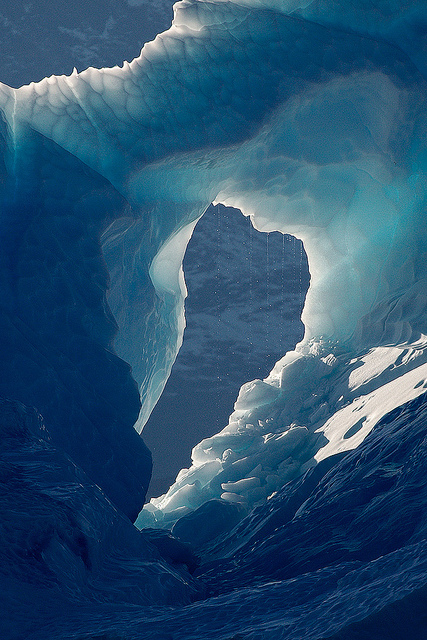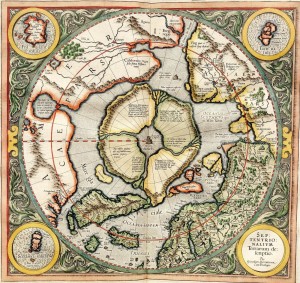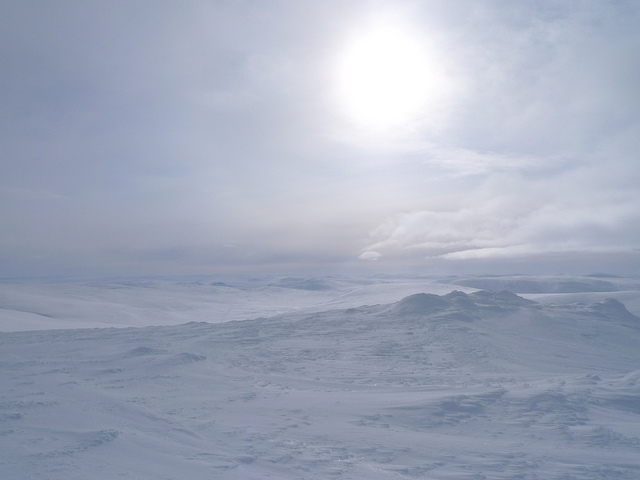You have no items in your cart. Want to get some nice things?
Go shoppingAli Shaw looks at the enduring idea of the North Pole in imagination and literature, a mysterious place of supernatural beings, prisons, snow palaces, eternal nights and endless days, the point where the world stops turning.

At the top of the world is a white land where the snow decides everything, where the wind blasts so cold it can burn you, where prismatic lights dance in the sky. Here a year is but a single day and its torturous evening. To here all compass needles point. The god of this land is the white bear, making red riddance of the seals who gasp up through the ice. To come here you must risk not only the bear’s meathook claws but the jaws of the orca, the nose of the wolf, perhaps even the magic of some stranger being stepping across the tundra, for in the far north they tell tales of mad devils and snow witches, and of Qalupalik and the Waheela.
Few even try to journey here, and those who do are adventurers all, seasoned by easier extremes. To come here means sleds and huskies, ice picks and snow caves, frostbite and hunger and perhaps even cannibalism and perhaps, worse, a seeming eternity spent with only the blizzard of your own thoughts for company. Should you survive, should you break far enough through the ice, you may come at last to one of only two points on the planet where the world stops turning, and it is this place, this North Pole, that draws all brave souls just as it draws their compasses.
Or so it goes.
In truth there are two North Poles, and neither of them stays still. First there is the northern axis of the Earth, currently poking out of the sea about 430 miles off the coast of Kaffekluben Island. Second is the North Magnetic Pole, currently wavering towards Russia from Ellesmere Island, where you will find yourself if you follow your compass to its utmost. Often the North Poles are underwater, often they are sealed up by ice. It is dull up there and very cold, and while there are occasional signs of bears and detouring seabirds, there isn’t much in the way of wildlife or spectacle. Do not believe them when they tell you that real life is stranger than fiction.
In the early 20th century, the idea of the North Pole drew many an intrepid explorer, often to their deaths. There is still controversy over precisely who got there first, so Robert E. Peary’s subdued account of his arrival there, heralded as the first by any human being, may be a work of polar fiction.
If it were possible for a man to arrive at 90° north latitude without being utterly exhausted, body and brain, he would doubtless enjoy a series of unique sensations and reflections. But the attainment of the Pole was the culmination of days and weeks of forced marches, physical discomfort, insufficient sleep, and racking anxiety. It is a wise provision of nature that the human consciousness can grasp only such degree of intense feeling as the brain can endure, and the grim guardians of earth’s remotest spot will accept no man as guest until he has been tried and tested by the severest ordeal.
– Robert E. Peary, The North Pole
 Long before any explorer attempted to reach the Pole, the world’s readers had paid regular visits in their imaginations. In the 14th century, a book entitled Inventio Fortunata was presented to Kind Edward III. It was the account of a Franciscan friar who had travelled the North Atlantic in the early 1360s, and it contained what is believed to be the first account of the North Pole. Regrettably, the book was lost, and all that remained was a paraphrase in a second book, the Itinerarium, written by Jacobus Cnoyen in the 1490s. This, too went astray, but a third iteration survived in the letters of the 16th century cartographer Gerardus Mercator, wherein he retold Cnoyen’s retelling of the Inventio Fortunata’s account as follows.
Long before any explorer attempted to reach the Pole, the world’s readers had paid regular visits in their imaginations. In the 14th century, a book entitled Inventio Fortunata was presented to Kind Edward III. It was the account of a Franciscan friar who had travelled the North Atlantic in the early 1360s, and it contained what is believed to be the first account of the North Pole. Regrettably, the book was lost, and all that remained was a paraphrase in a second book, the Itinerarium, written by Jacobus Cnoyen in the 1490s. This, too went astray, but a third iteration survived in the letters of the 16th century cartographer Gerardus Mercator, wherein he retold Cnoyen’s retelling of the Inventio Fortunata’s account as follows.
In the midst of the four countries is a Whirl-pool, into which there empty these four indrawing Seas which divide the North. And the water rushes round and descends into the Earth just as if one were pouring it through a filter funnel. It is four degrees wide on every side of the Pole, that is to say eight degrees altogether. Except that right under the Pole there lies a bare Rock in the midst of the Sea. Its circumference is almost 33 French miles, and it is all of magnetic Stone (…) This is word for word everything that I copied out of this author Jacobus Cnoyen years ago.
– A letter dated 1577 from Mercator to John Dee, presented in a paper by E. G. R Taylor
Jules Verne imagined just such a magnetic mountain in his 1875 novel The Field of Ice. “The new continent was only an island,” he wrote, “or rather a volcano, fixed like a lighthouse on the North Pole of the world. The mountain was in full activity, pouring out a mass of burning stones and glowing rock. At every fresh eruption there was a convulsive heaving within, as if some mighty giant were respiring.” Verne’s central character, a polar explorer, is so determined to set foot on the Pole that he strides into the heart of that lava. The Pole is often portrayed as such an other-worldly place, and that’s what gives rise to tales of its other-worldly denizens. The bulk of the narrative in Mary Shelley’s Frankenstein is framed by the account of a Polar explorer who comes upon the monster in the blistering ice fields. In Philip Pullman’s Northern Lights, the terrifying Gobblers conduct their experiments at Bolvangar research station, where their deeds can be concealed behind snowstorms. The Arctic in such stories is a land as much beyond the bounds of morality and the human psyche as it is beyond the limits of survivability. You do not stay in the Arctic, you escape, and doing so always requires more than just a snowmobile. There are prisons there, like Bolvangar, and like the Snow Queen’s palace in Hans Christian Andersen’s masterpiece, where “the walls were made of drifting snow and the windows and doors of razor-sharp winds. There were over a hundred halls, all of them shaped by the drifting snow… so empty, so icy cold, and so glittering.”
There are, of course, those who long ago mastered the art of survival in such conditions, whose architectures are ingenious not because they cage and torture but because they turn the fabric of hostile nature into a protection against itself. In The Snow Tourist, Charlie English recounts his experience of igloo building in Iqaluit, Qikiqtarjuaq. “There were few better building materials than snow,” he writes. “There was something perfect about its transience. What structure could exist in better harmony with the earth than an igloo, which creates no waste and leaves no footprint?” The Inuit are believed to have learned much of their snowcraft from a prior indigenous culture, the Dorset People (I like this, being a Dorset person myself), but we don’t have much of a record of them. What we do have are the Inuit’s wondrous traditional stories, which tell us more about life around the Pole than any explorer’s temporary stay. Crow Brings Daylight, for example, gives an insight into what day-to-day life might feel like if a day lasts for six months. In that tale, the Inuit live for an eternity in darkness, until Crow flies south and steals for them an orb of daylight. After flying it home to the Arctic, he smashes it against the ice, whereupon light bursts forth and illuminates the world. After many months the light fades, but Crow instructs the Inuit not to despair. The orb will slowly regain its powers, and in half a year the light will shine again.

The geographer Yi-Fu Tuan, in his book Escapism, records this of the Inuit, “Happy people have no reason to think; they live rather than question living. To Inuits, thinking signifies either craziness or the strength to have independent views. Both qualities are antisocial and to be deplored.” The type of thinking Tuan is referring to here is the kind that questions why the world is the way that it is, as if to question it might be somehow to change it. That kind of thinking is often valued in Western cultures, but perhaps the ice does not abide such self-indulgence. Ted Hughes wrote a short story, Snow, in which an amnesiac wanders five months in an Arctic blizzard, with only his dreams to inform him of the memories he might have had from his life before. Yet this wanderer tries diligently to drive from his mind all thoughts unrelated to survival. “They are the infiltrations of the snow,” he says of such things, “encroachments of this immensity of lifelessness. But they enter so slyly! We are true they say, or at least very probably true, and on that account you must entertain us.”
Perhaps this is the real magnetism of the Pole, the thing that draws the restless spirit of the explorer: that to strive to reach it is to purge all other thoughts and achieve simplicity, a kind of barren purity that only the stilling of the Earth can provide. Robert E. Peary said, “The determination to reach the Pole had become so much a part of my being that, strange as it may seem, I long ago ceased to think of myself save as an instrument for the attainment of that end. To the layman this may seem strange, but an inventor can understand it, or an artist, or anyone who has devoted himself for years upon years to the service of an idea.” It seems to hold true that the deathliness of the landscape is the same thing as its beauty. That the chafing cold might rip away all human superficiality and face us with the naked cores of our selves.
Amy Sackville, in The Still Point, describes the ice of the polar regions in the most elegant prose I have found on the topic. She writes this:
It is beautiful, he thought, as they stood in despair looking out at the sculpted surface. Like an ocean in arrest. Crests and flats, the light trapped in hollows, elsewhere deep blue shadows pooling, or a roseate rainbow in a translucent arc of ice; in places the snow curved over itself, a wave in the moment before breaking, creating a cave that he longed to curl into. Such a landscape is beautiful indeed, and treacherous and almost impossible to cross.
– Amy Sackville, The Still Point
Then there is this, from Jack London, albeit written about land further south, but of the same inhospitable cold.
The land itself was a desolation, lifeless, without movement, so lone and cold that the spirit of it was not even that of sadness. There was a hint in it of laughter, but of a laughter more terrible than any sadness — a laughter that was mirthless as the smile of the sphinx, a laughter cold as the frost and partaking of the grimness of infallibility. It was the masterful and incommunicable wisdom of eternity laughing at the futility of life and the effort of life. It was the Wild, the savage, frozen-hearted Northland Wild.
– Jack London, White Fang
For those of us who venture there, the Pole is an absolute. A kind of surgery. Only day, then only night. It is the closest thing we have, living as we do on a globe, to the end of the Earth, and therefore perhaps the closest thing we have to any kind of certainty. For those of us who are never likely to brave that journey, save in our reading, the Pole is fiction and reality blurred. There, on the frontier of the inhabitable world, we can perhaps still believe in armoured bears and snow queens, and be all the better for it.
*
My thanks to everyone who sent me pieces to include here: I’m sorry I couldn’t use everything. Thanks, too, to those of you who sent me ideas for Antarctica. I’m going to use those in a future entry.
Next time, we’re going to crank up the temperature and head after the mirages of the desert. I’m not sure which desert we’ll travel through just yet, since it depends on what literature I can find. Perhaps it will be the Sahara, perhaps it will be all the deserts of the equator. I’d love to hear from you if you’ve read anything on the subject, any fiction or poetry or travel writing (or anything else) that stood out for you. You can drop me an email, get in touch on twitter, or simply leave a comment in the section below.

About Ali Shaw
Ali Shaw is the author of the novels The Man who Rained and The Girl with Glass Feet, which won the Desmond Elliot Prize and was shortlisted for the Costa First Book Award. He is currently at work on his third novel.





A beautiful piece on the mysteries of the North Pole in literature and the imagination by @Ali_Shaw on Litro today https://t.co/ijvvY9B1Ti
The Written World: The North Pole | Litro https://t.co/wjuqcD8t9H